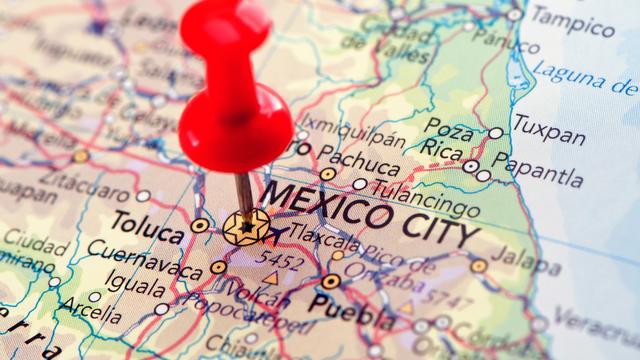Do you want to start a restaurant, but you don't know what positions you should fill? Not sure how many people it takes to prepare and serve a dish?
Indeed, they're more than what you think!
In this article, I will tell you a bit about the positions that may exist in a restaurant and the functions of each staff member.
In addition, I will give you an example of what an organization chart with these positions would look like.
This guide will also illustrate the importance of each role in the proper functioning of a good dining room: from the owner to the person in charge of taking out the garbage.
Let's get started!
What Are The Different Positions In A Restaurant?
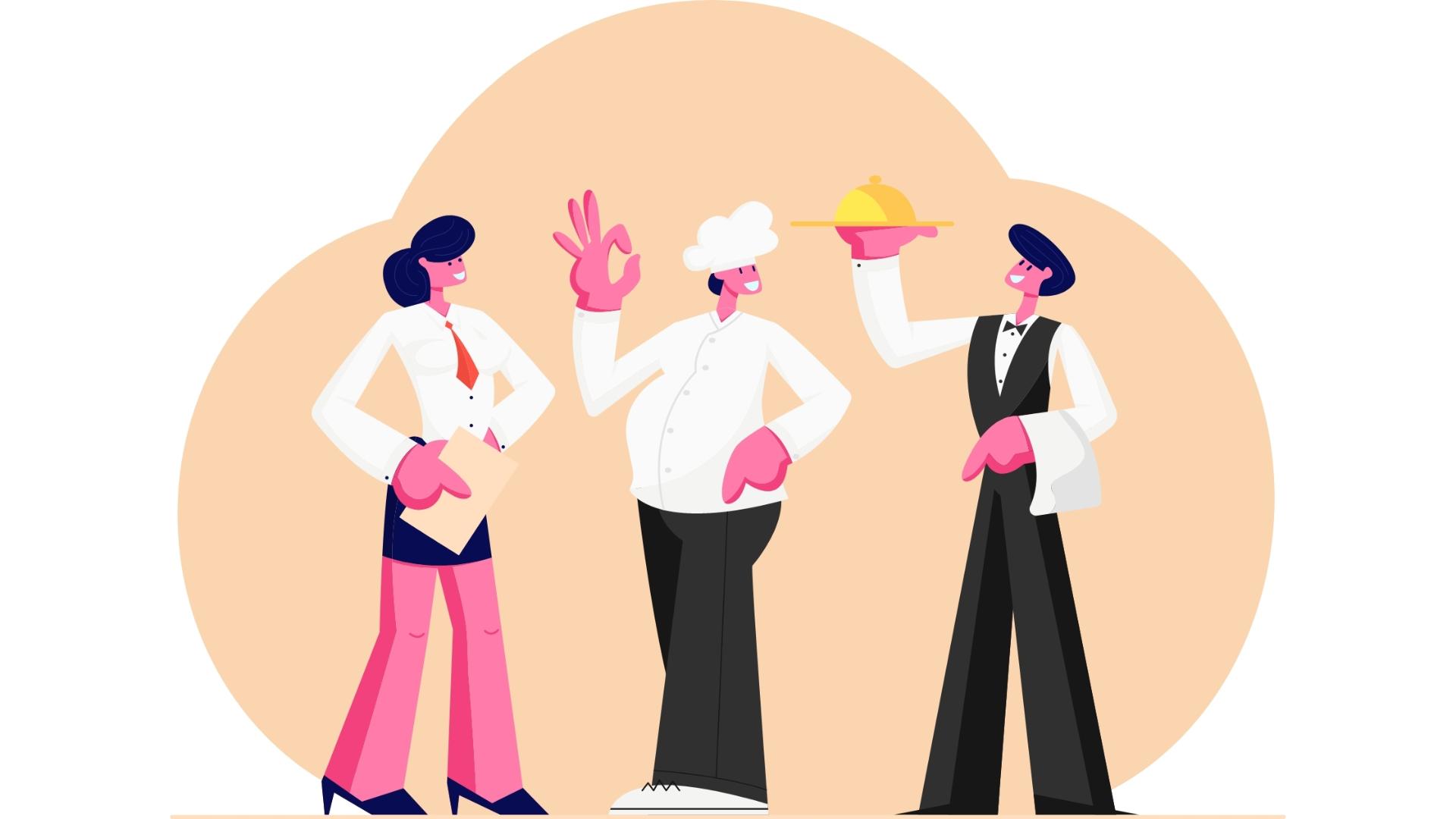
Different positions fulfill specific functions in a restaurant.
Each of them is very important so that everything is kept in order and the dining room flows correctly.
We should note that the larger and more complicated the establishment, the more positions will require attention from the human resources team.
Some positions become less necessary for small establishments, which means that specific tasks are divided among the existing employees.
In this guide, I have added all the positions that can exist in a large restaurant or hotel. Here is the list:
- Administrative positions
- Managers
- Administrator
- Kitchen staff
- Executive chef
- Kitchen manager
- Sous-chef
- Station chef
- Cooks
- Assistant cooks
- Cleaning team
- FOH staff
- Head waiter
- Receptionist
- Sommelier
- Bar staff
- Waiters
This is the personnel required for an establishment that has to be in constant operation, and consequently it has a complex organizational chart.
Administrative Positions of a Restaurant

At the top of the system we find the administrative staff of the restaurant.
They are the ones in charge, of course, of managing everything that is done in the restaurant.
1. Manager and his functions
The manager is the person in charge of the restaurant. In small restaurants, the manager is usually the owner.
On some occasions, a manager is simply a person who takes the reins. The owner chooses the manager to manage every aspect of the restaurant in his stead.
A person who is appointed as a manager must be highly capable to:
- Run the business and every aspect of it.
- Make important decisions, such as the restaurant's theme, its operation, and other administrative decisions.
- He is usually in charge of managing the appearance of the establishment, the marketing strategy, and more.
- He is the person with the most responsibility at a legal level.
Thanks to the fact that it fulfills so many vital functions, it is recommended that an appointed manager is a person with administrative studies and general knowledge of the hospitality niche.
2. Administrator / Secretary and his functions
The administrator or secretary is the person who is in charge of the practical economy of a restaurant.
He works in constant contact with accountants and bank accounts, as he must be in charge of managing the capital of the establishment and ensuring its proper use.
In addition, it usually is also in charge of hiring and firing personnel, payroll, daily earnings, and everything that has to do with the establishment's profits and/or losses.
This is one of the most critical roles in a restaurant - if you are looking for a job in a restaurant, he is also one of the people you should impress.
Back-of-house (BOH) Staff
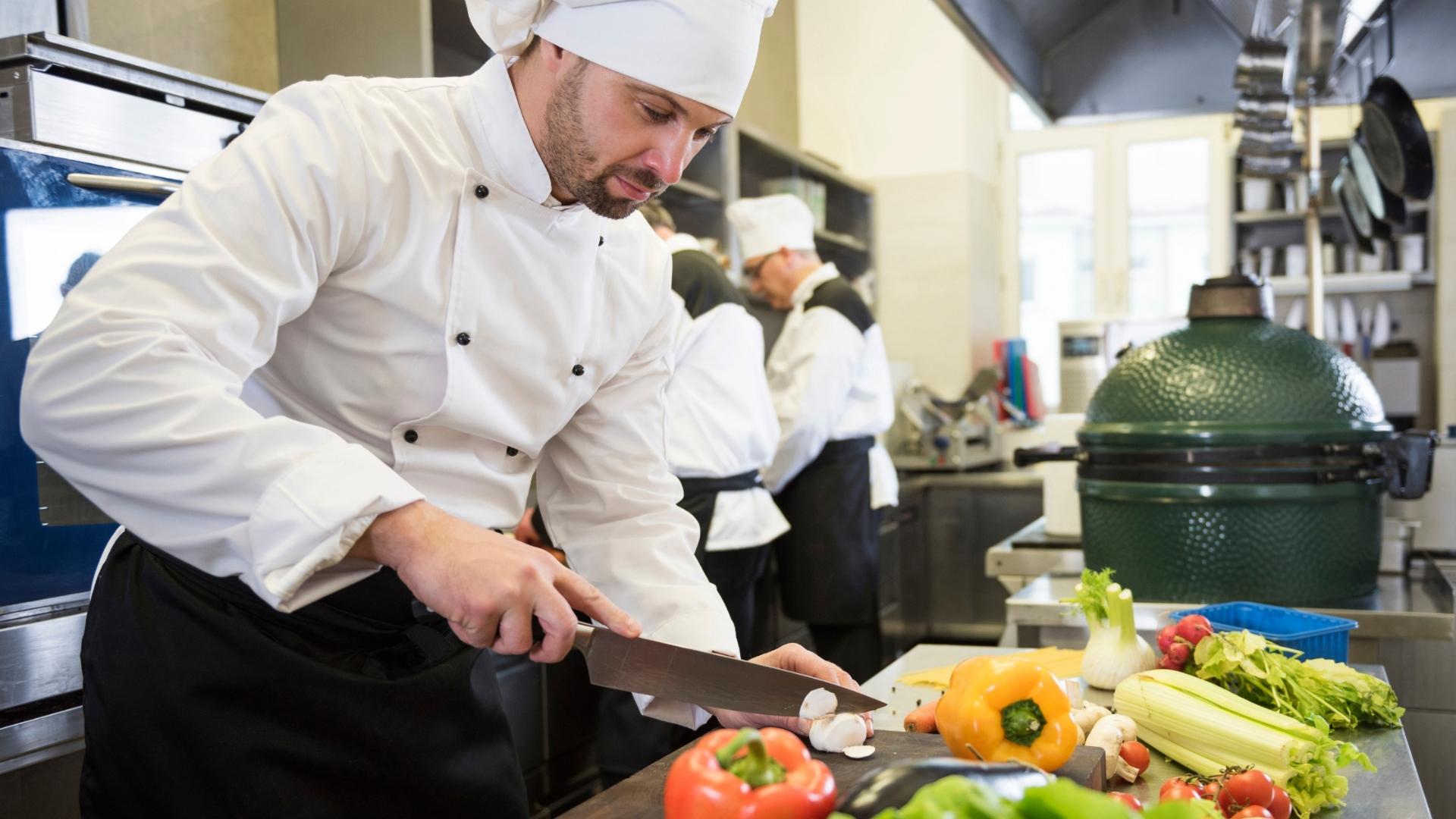
After the administrative staff comes the kitchen area employees, or as I like to call them - the soul of the restaurant.
Why? Because even if you don't see them, they keep the restaurant alive.
1. Chef / Executive chef
The chef is the third most crucial role in a restaurant.
An executive chef is part of the administrative staff and one of the most critical roles in a kitchen.
Its functions are:
- Creating a menu that all diners will love: from the largest to the smallest dish.
- Direct all the kitchen employees and their different stations.
- Make administrative decisions about what is served in the restaurant.
- Ensuring the efficiency of a kitchen team.
- He is in contact with all the different roles in the restaurant: from the maitre d’ to the cleaning staff.
This position only goes to cooks with a high level of practical experience. In addition, they usually have some type of complementary education, such as a diploma in culinary arts, among others.
The executive chef is one of the first positions to consider even before starting the restaurant. His experience can help organize it from the get-go.
2. Purchaser/Kitchen Manager
In large restaurants, there is the role of kitchen manager.
In small establishments, this position is absorbed by the administrator, the executive chef, or divided between both.
The purchasing manager is in charge of carrying out complete inventories of everything in the kitchen - he must make sure that all the ingredients are available.
3. Sous-Chef
The sous-chef is the chef's right hand - if the head chef is absent, the sous-chef is the commanding officer of the cooking brigade.
He is also in charge of carrying out the chef's orders to the letter.
Traditionally, filling the sous-chef position is left to the executive chef. Both must have excellent work chemistry and a lot of trust in each other.
In addition, it is common for the sous-chef to earn his position after going through the various stations of the kitchen successfully.
4. Station chef
The station chef or departure chef is in charge of a specific section within a kitchen.
The station chef reports directly to the executive chef and the sous-chef.
There are different starting chefs:
- Sauce maker/sauce chef: Supervises the fish cook and the seafood cook.
- Pastry chef: He is in charge of supervising pastry chefs, pastry chefs, confectioners, and ice cream makers.
- Pantry Chef: Supervise the butchers and butchers.
- Rotisserie Chef: He is responsible for the grill and fries cooking.
- Hors d'oeuvre / starter chef: He supervises the cook of stews/soups and the vegetable cook.
Each of these positions is filled by cooks with experience in each section.
5. Cooks
Cooks are the hands of the kitchen and comform most of the back-of-the-house staff - they are in charge of executing all orders under the supervision of the station chef, the sous-chef, or the executive chef.
This position is one of the most important in a practical way since cooks are in charge of preparing absolutely everything that comes out of the kitchen to be enjoyed by the diners.
6. Assistant cooks
Assistant cooks are in charge of all kinds of important jobs for the operation of each station, without being directly in charge of cooking or preparing any dish.
They are in charge of preparing the work area, organizing and cleaning each preparation table under the orders of the station’s chef.
In addition, they take care of the production area of each station, which includes cleaning and cutting vegetables, cleaning and preparing proteins, and much more.
They are also in direct contact with the cleaning crew, as they make sure that every piece of equipment reaches the dishwasher area after it’s used.
7. Cleaning staff
The cleaning team is as important as all the other positions - in fact, its importance increases with the size of the establishment.
This category includes dishwashers, those that clean the cooks' work tools, and those that clean the kitchen in general.
In small establishments, the dishwasher position is usually covered. All the kitchen workers carry out the other cleaning tasks at the end of each day.
Front-of-the-house (FOH) Staff and Their Functions
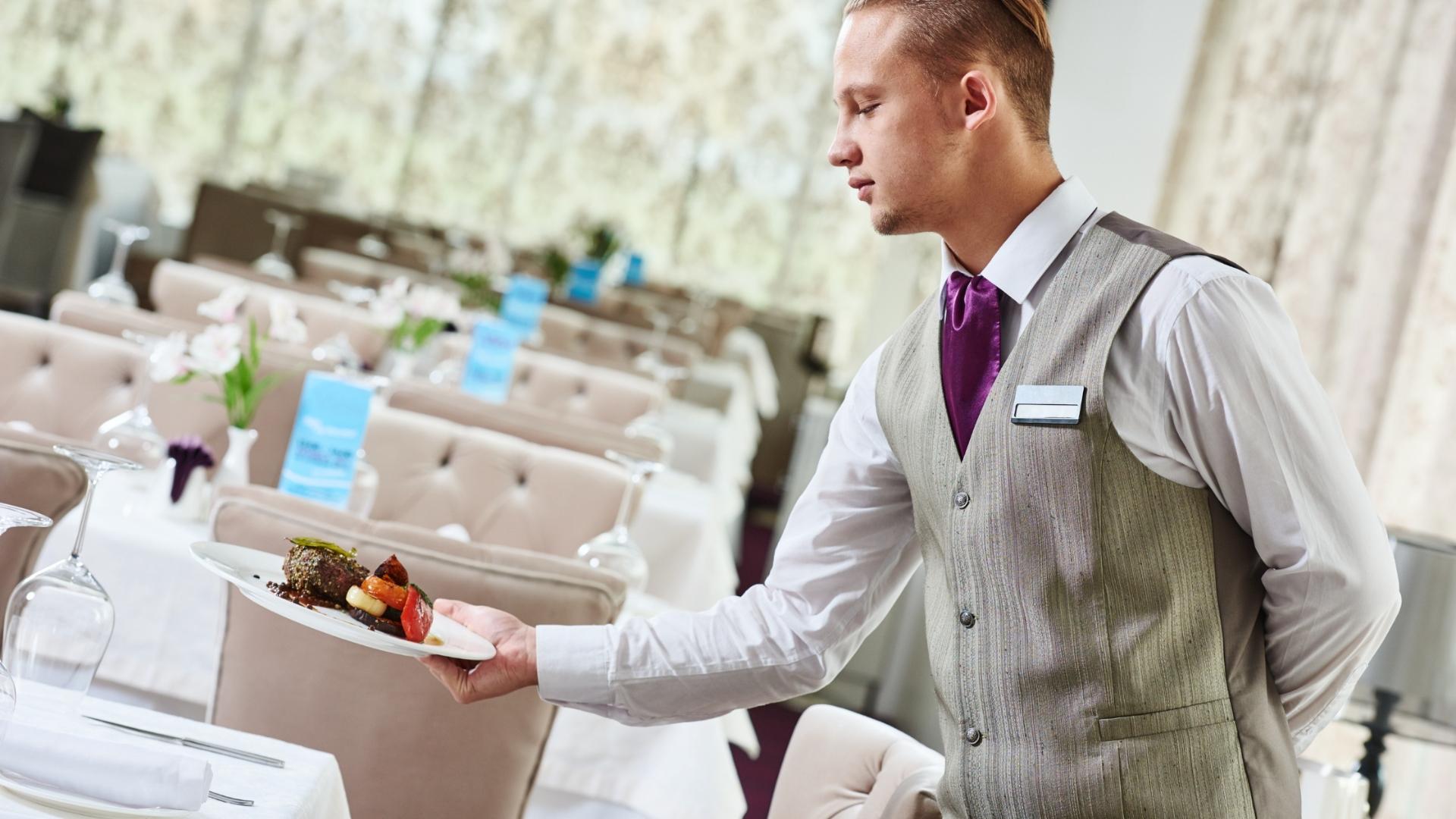
Now that you already know each of the roles of a kitchen that are not normally in plain sight, it’s time for you to know the ones that are.
1. Maitre d ' or head waiter
The maitre d' or head waiter is essentially the same position.
This position is vital for the diners' comfort.
Its functions are:
- Accommodate each diner at their table and provide the menu.
- Give direct orders to the front-of-the-house staff or waiters, in addition to ensuring that they comply with good personal presentation and excellent treatment to customers.
- Be attentive to the needs of diners.
- Present the account at the end of the service.
- They are in charge of training new waiters and room cleaning staff.
This position is reserved for people trained in the area of service and customer care. They should also have excellent social skills.
In addition, it is sometimes required that you have specific skills, such as speaking different languages, knowledge of enology to fulfill sommelier duties, and more.
2. Receptionist
A receptionist is a person in charge of receiving diners and verifying their reservation - also regulating their entry and dress code.
This is also a position that requires a person with exceptional presentation and manners.
3. Sommelier

When it comes to a large restaurant, there may be a sommelier role.
The sommelier is an expert in oenology - his job is to recommend the right wine for the occasion and/or dish.
In addition, the sommelier must be in direct contact with the executive chef or sous-chef to find out which wine or drink is most suitable for each dish.
4. Bar staff
In large and fine dining restaurants, a bar is usually included for diners to wait for their companions or table.
There are different roles in a bar:
- The bartender is dedicated exclusively to dealing with customers and preparing cocktails to their liking or found on the spirit’s menu. This person must have extensive knowledge of mixology and different beverage preparation techniques.
- Bartender Assistants- Like kitchen assistants, bartender assistants prepare everything necessary for the bartender to prepare cocktails, including preparing ingredients and cleaning the bar area.
- Barista: a barista is a person dedicated to preparing drinks such as coffee, other infusions, shakes, smoothies, and more. Sometimes the bartender doubles as a barista as well if he has the necessary experience.
In small restaurants, these positions are sometimes filled by waiters with experience in beverage preparation - although this isn’t the most efficient practice.
5. Waiters: Types of waiters and their functions
Waiters are the workforce and face of a dining room.
Depending on the organization of the restaurant, there are different types of waiters, especially in bigger establishments:
- Waiters: They are in charge of bringing orders to the kitchen and delivering the dishes once they are ready. In small restaurants, they can also clean and rearrange the table once the diner has left. Other functions include handing over the bill to diners, receiving complaints or congratulations, communicating them to kitchen staff, and even billing for the services.
- Runners: In large restaurants, they are specifically in charge of bringing the dishes to the table. They work in large crews so that all dishes arrive simultaneously and at the correct temperature - this is also common with waiters.
- Room cleaning team: In large restaurants, they are specifically in charge of cleaning and rearranging each table after the diners have left.
Waiters are the people with whom you have the most contact when going to a restaurant, regardless of the nature of the business.
For that reason, they are an essential part of the service of a restaurant!
Restaurant Staff Organization Chart
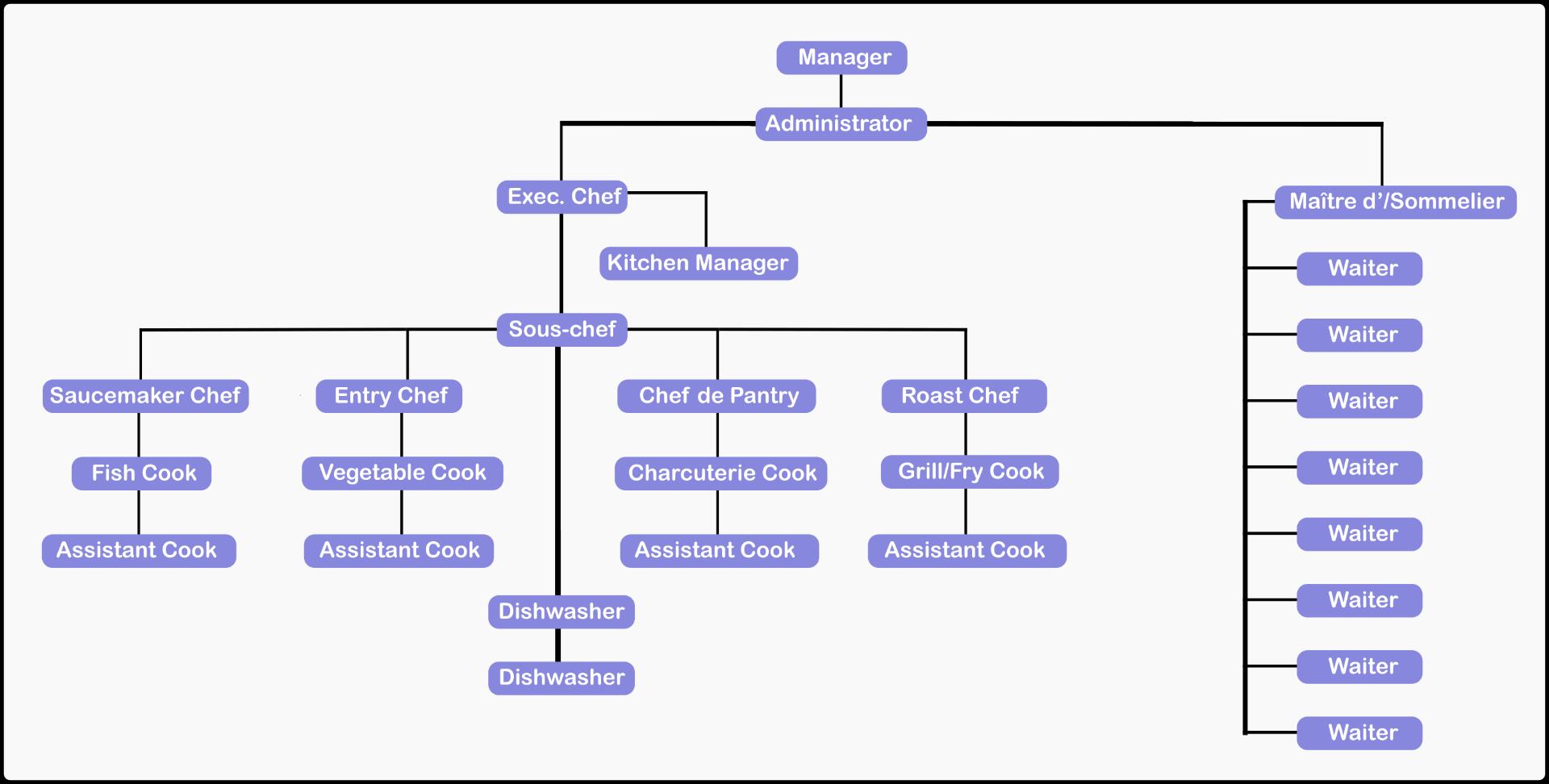
The following organization chart for a small/medium restaurant will serve as a visual aid to give you an idea of the hierarchy of some of the positions.
It is worth mentioning that regardless of the organization chart and hierarchy of a restaurant, each of the staff members must have a professional relationship of respect with each other.
In many restaurants, employees treat each other like family, which is very beneficial in improving the mechanics of teamwork.
This is something that managers, administrative staff, and executive chefs should encourage!
Tip: A Well-Organized Restaurant Is Guaranteed Success
Each of these positions is very important for the proper functioning of a restaurant.
If any one of them fails, the restaurant begins to be at risk of dying as an establishment:
- Without someone who manages capital well, a sustainable restaurant cannot be maintained.
- If there is no one to cook, the restaurant does not work.
- If there is no one to serve, no one eats in the restaurant.
- If there is no one to clean and organize the restaurant, no other worker will perform adequately. Or no one would dare enter the restaurant in the first place!
Therefore, every time you go out to eat in a restaurant, keep in mind that the work of at least 10 people or more is necessary for you to enjoy your meals.
Don't forget to tip!
Useful Articles For New Restaurant Owners
Here are some informative articles from our blog that will be helpful for new restaurant owners:
- How to do restaurant marketing? 24 creative ideas
- Equipment needed for a restaurant kitchen
![Complete List of Restaurant Staff [Roles + Responsibilities]](https://www.imagelato.com/images/article-cover-restaurant-staff-list-e9d70f7c-1024w.jpg)


